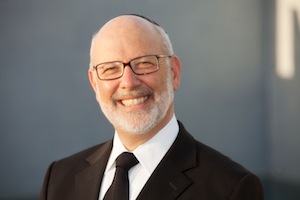The natural and the supernatural
The idea of miracle covers a spectrum of event-types. On the one end of the spectrum some miraculous events seem to be quite natural and on the other end we call supernatural events miracles. I just had the thrilling privilege of being the Sundek at my grandson's bris in Israel. The birth of a perfect little child is always a miracle, but it is natural. What happened with the oil that burnt in the Beis Hamikdash eight times longer than it should naturally have burned was a supernatural miracle. On that first Chanukah in the time of the Maccabees another miracle occurred too, but this other miracle was natural; it was the victory of the small band of Torah-committed Jews over the mighty Greek armies of Antiochus and the Hellenist Jews.
Bust of Antiochus IV at the Altes Museum in Berlin.

The Maccabee victory was an unlikely one but nevertheless not one that defied rational explanation. It was what we call a neis nistar, a subtle miracle.
The Meshech Chochmah (Bereishis 37:24) deduces from theRambam's detailed recounting of the military victory (Chanukah 3:1) that the victory is at the core of the Chanukka theme and the oil miracle is secondary. This also evident from the Al Hanissim piece that we add into the shmoneh esrei during Chanukah. The military victory made it possible for the Maccabbees to re-occupy the Beis Hamikdash and find the small container of oil. The reason we make the beracha of asher asah nissim la'avoseinu (the blessing for the miracles that Hashem did for our fathers) on the lights even though the main miracle was the war, is because the war was a neis nistarwhereas the oil miracle was a neis galuy (a supernatural miracle). We can only make the beracha on a neis galuy, not on a neis nistar.
Joseph's miracle
At this time of year the Torah reading revolves around the story of Yoseif and his brothers. Yoseif is thrown into a pit full of snakes and scorpions and emerges unscathed when his brothers lift him back out of the pit to sell him to the passing traders. Years later, after burying his father, Yoseif revisits the pit from which he was saved and pauses there a moment to say the beracha of baruch she'assah li neis bamakom hazeh - "blessed be He who performed a miracle for me at this place." (R. Tanchumah, Midrash Rabbah 100:9) Once again the Meshech Chochma points out that the main miracle was the turn of events that led to Yoseif becoming viceroy of Egypt and saving the Jewish nation from famine. Nevertheless, this story, unlikely as it is, like the story of the Macabbees doesn't defy rational explanation. It was a neis nistar and Yoseif needed to go back to the place of the neis galuy, the pit from which he was supernaturally saved, to say his beracha.
Time and place
There is an interesting difference between Yoseif's celebration of the miracle of his salvation from the snakes and scorpions, and our celebration of Chanukah. Yoseif goes back to the place of the miracle but not to its time. We observe the time of the Chanukah miracle but not its place. This is why Yoseif's beracha focuses onmakom hazeh - this place, whereas our beracha for the Chanukah lights focuses on bayamim haheim, bazman hazeh - in those days at this time. But this difference is not as important as it may seem. Jews treat time in much the same way as we treat place.
We mark time with landmark events, and we revisit these landmarks every year. We have a national nostalgia for these landmarks in much the same way as people have nostalgia for landmark places that hold special memories for them. When we go back to meaningful places we re-live the events that happened there and reconnect with those experiences. As Jews we do the same with our revisiting of landmarks in time. We reconnect with the Exodus each Pesach, with the giving of the Torah each Shavuos and with the miracle of Chanukah every Kislev.
You will find that by creating frequent landmarks in time and revisiting them you will add richness and texture to your life. We do this already with birthdays and anniversaries, but try to do it with every meaningful event in your life. Make a note in your calendar when something special happens and re-experience that event the following year or even years. With electronic calendars this is easier than ever. As you add landmarks to your calendar, (you can probably find something to add each day), future years will be filled not only with their own experiences but also with re-living the joys of previous years that occurred in those days at this time. This enrichment is part of the gift of Chanukah.








